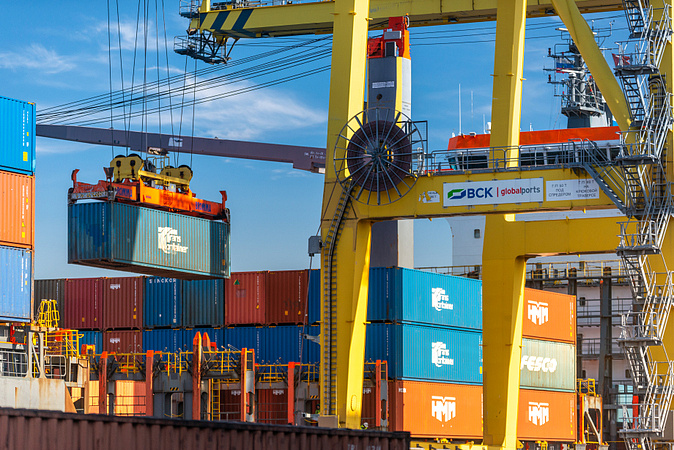





Many companies face the problem of determining the weight and dimensions of their cargo at the warehouse. This cargo must be then placed into trucks and shipped to clients.
Main reasons why these calculations are required:
1. Avoid penalties for overload;
2. Increase truck utilization without exceeding axle load limit;
3. Provide maximum space usage inside the truck.
Companies try various methods to avoid overload, namely:
· Teach the warehouse how to ‘correctly’ place cargo
This option is possible only of the products that are to be shipped are the same and are transported on the same vehicles. In the given case, there is no need to spend money on additional solutions or software. However, this situation is quite rare. Companies typically hire third-party transport and orders have various products by weight, dimensions, and it becomes difficult for the warehouse to handle this task in a timely manner.
· Reducing the total cargo weight
This option is favored by many third-party transports to limit the transportable weight (for example, 20 tons). This too is not the best solution, however, since space utilization is also reduced and the possibility of an overload is not eliminated. For example, if the total weight of heavy pallets cannot exceed the limit, but their dimensions cannot fit into the truck then an overload could occur for one of the axles.
· Loading with scales weight control
As shown in practice, this is a rather long process. If after loading it is determined that there is an overload upon out-gate, it must return to the warehouse, unload a part of its load, reload the cargo – which requires a lot of time. Moreover, the scales could be out of order and the weight calculation could be inaccurate as a result.
· Automatic load modeling using special software.
The given method makes it possible to plan the loading sequence into the truck in the shortest amount of time with consideration of weight and dimensions. The software can plan axle loading in advance. This option is the most effective and fastest method, which is described in more detail below.
Today’s WMS systems, as a rule, have extensive functionality and even routing of goods for truck loading. At the same time, they do not optimize stowage into trucks with consideration of axle load limits.
This requires a series of special solutions that must be integrated with the WMS for maximum efficiency. In the given article, we will look at examples of integration between these solutions and Solvo.WMS.
It is difficult to manually determine the distribution of weight on the truck axles. This can be done more effectively by a computer if the required parameters are known.
The more data points are known, the easier it is to calculate optimal loading. For example, this can be truck characteristics (weight limits, capacity, and axle weight limit), weight, and size of cargo items, loading-unloading sequence and road weight limits.
In result, the system will produce a loading scheme which can be printed and applied during loading operations. Loading optimization solutions make it possible to load into 1 tier or 2 (for lighter goods), while more complex stowage (e.g. for furniture, tires etc.) use rules that help prevent damage for such goods during transport.
The WMS system sends all the necessary information about the truck, goods, limits, and other specifications, for optimizing loading. Then, it creates a 3D model demonstrating the stowage method in the truck with a list of items slated for shipping into a specific truck and then send it back to the WMS system. Thus, the operator can see the given model in the screen with the option to print it.
Without WMS integration, the process in the loading optimization program took around 30 minutes for each truck, including assembly and entering data. Integration made it possible to reduce this to just 5 minutes since the incoming data from the WMS is sent automatically while the process of creating the layout itself takes just 20-30 seconds.
Integration example
After entering the gate, the truck moves to the scales and the information is sent to Solvo.WMS. Meanwhile, a “shipment” order is assigned for the truck in the system and when the truck data along with the planned loads are assembled, the system will require 1-2 minutes to generate the optimized layout. This layout will then be sent to the warehouse where the worker must use it to load the cargo into the truck.
Solvo.WMS includes a special button “Send data to loading optimization program” after which a request will be either send automatically or by the worker who could edit it or launch a report. No manual entry of any data is required. If something must be corrected, then it is possible to do it with the computer mouse in the 3D layout.
Upon out-gate after loading, the truck will again go to the scales to ensure that there is no overload after which the truck will depart. All calculations are stored for statistics if they are required at a later date.
By integrating Solvo.WMS with loading optimization systems:
• No file exchange is needed for entering and saving loading schemes;
• Loading schemes are received in Solvo.WMS automatically by pressing one button and without using the loading optimization program;
• All nuances related to generating cargo entries from the WMS system are taken into account;
• Over 500 loading maps can be created per day;
• Ability to create statistical reports for better analysis and decision-making.
Optimization Program in the WMS
There are 3 options for controlling how the loading optimization program by the WMS operator:
1: One-way
After sending data to the loading optimization program, the shipping operator will see the layout on the desktop computer and make sure that everything is in order. He will record the calculation results and can print a physical copy giving it to the forklift driver, who is responsible for loading the truck.
2: Special form in operator’s data capture device
The program will calculate the loading optimization, creating an image which is accessible via http or other methods. The forklift driver can open this form in the RDT and if the image is there, can view it on the RDT screen which will show two pictures: the first is a top-down view and the second is an image of the truck with the 3D loading scheme.
3: Using a second web-service,
The service is synchronized with the loading optimization program making it possible to receive the results by loading sequence for each pallet and its stowage method into the truck.
During loading, sometimes the jobs and the loads are substituted one for the other, which is why this is the most complex option out of the three. Meanwhile, loading jobs will be issued in accordance with the priority that is assigned for the load.
SOLVO is ready to offer a ready-made complex solution for warehouses including a WMS system and an already integrated module for truck loading optimization. The given solution is already working and being further developed at warehouses in Russia of one of the largest beer producers in the world




